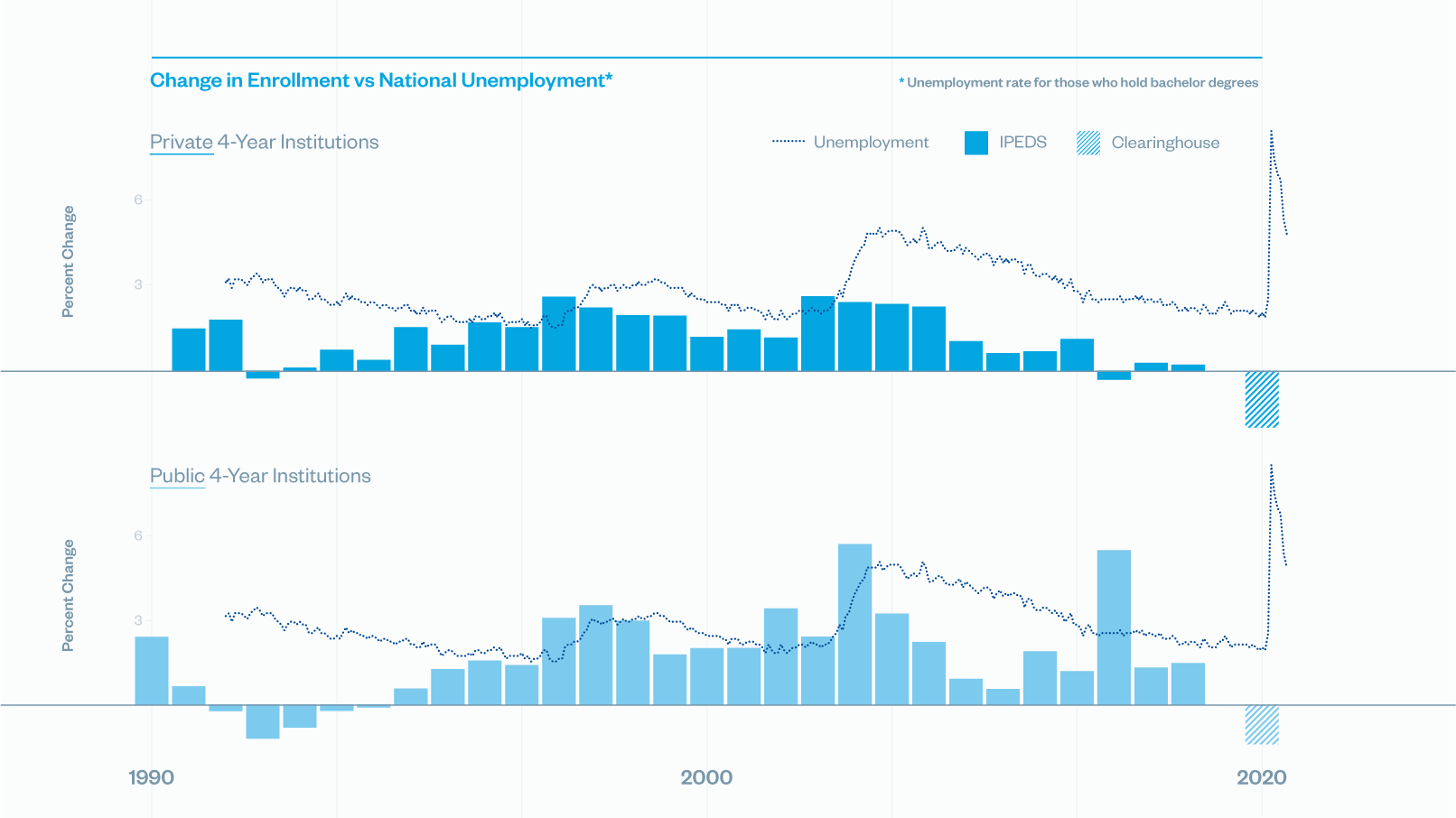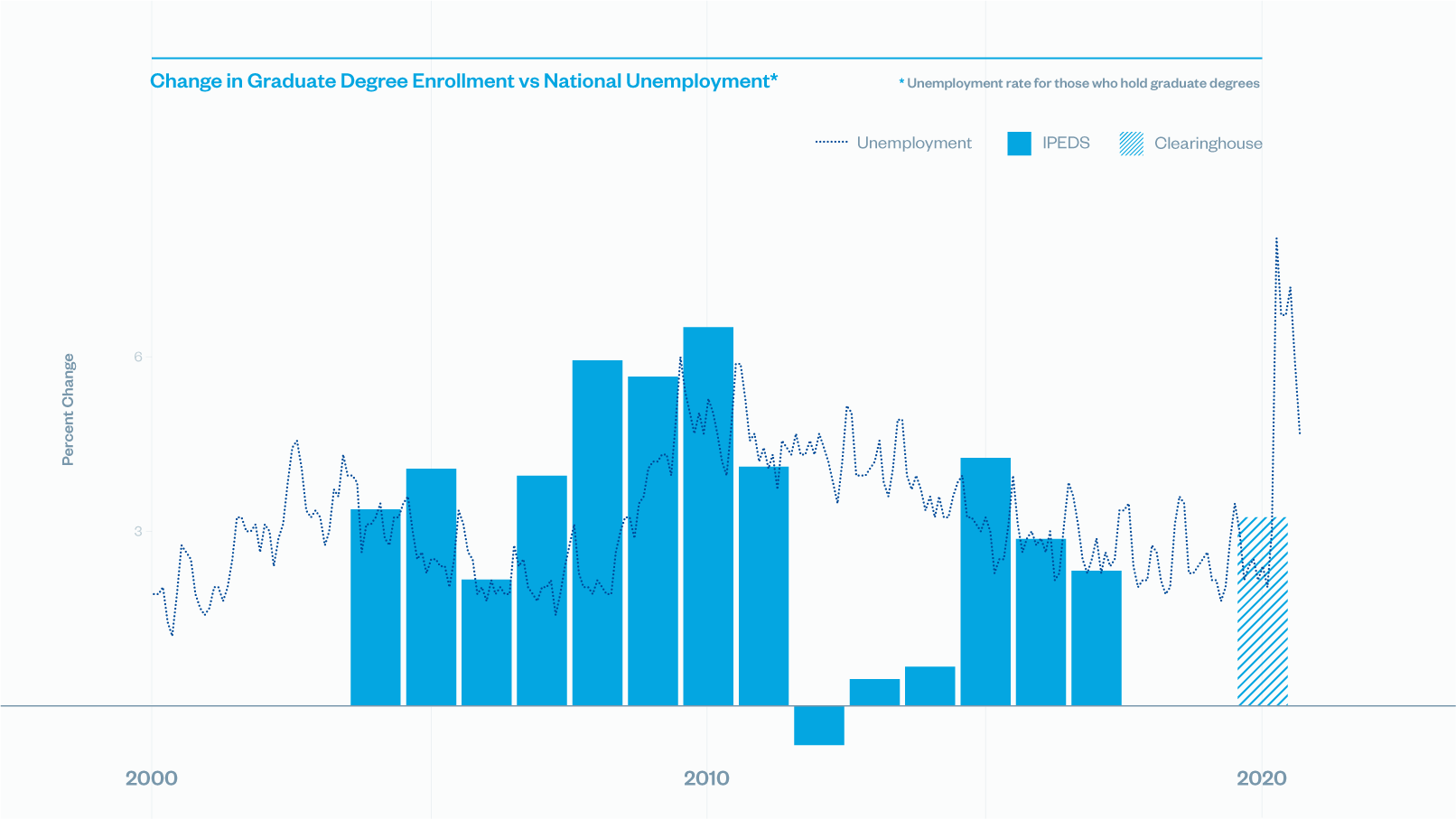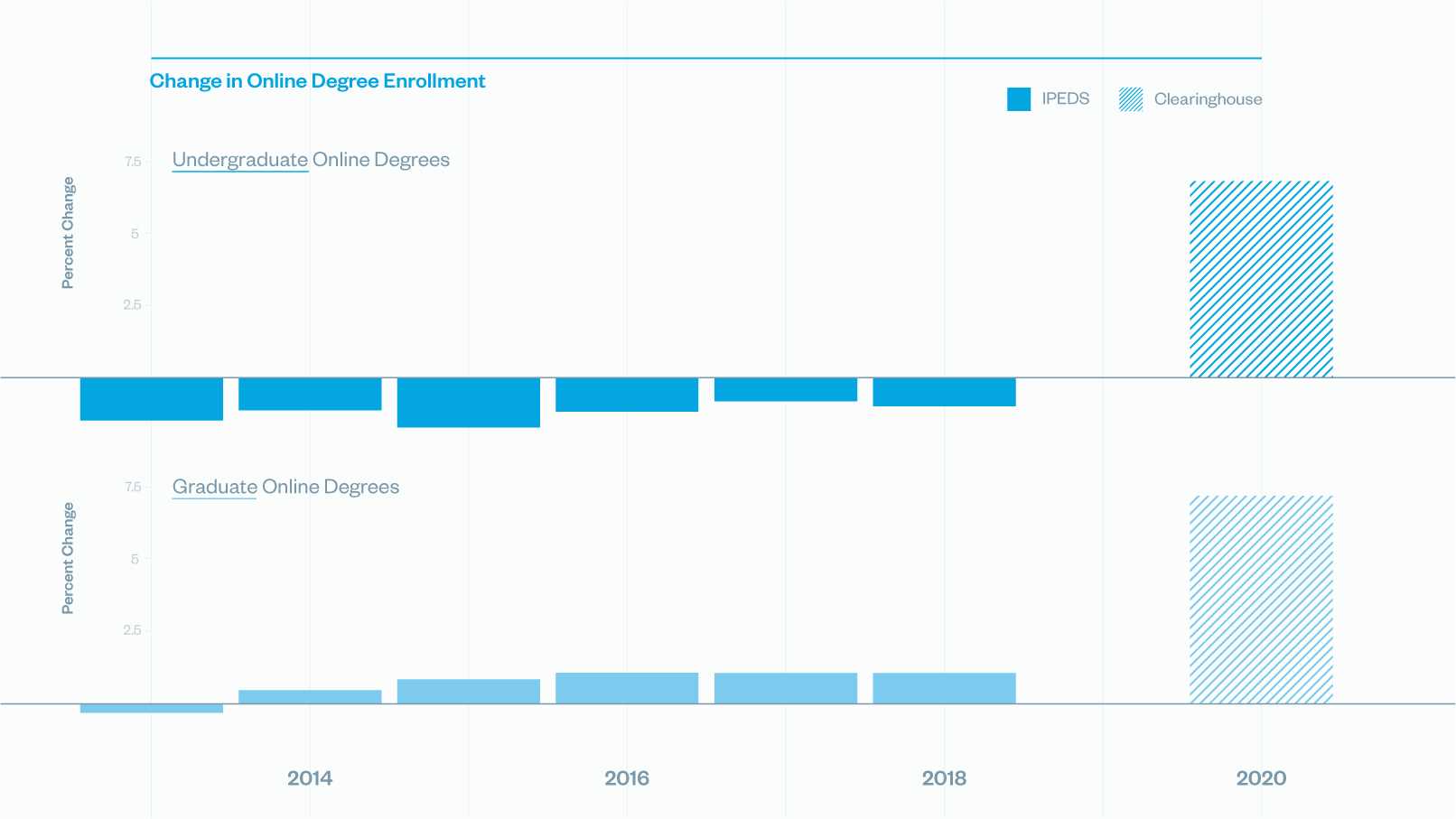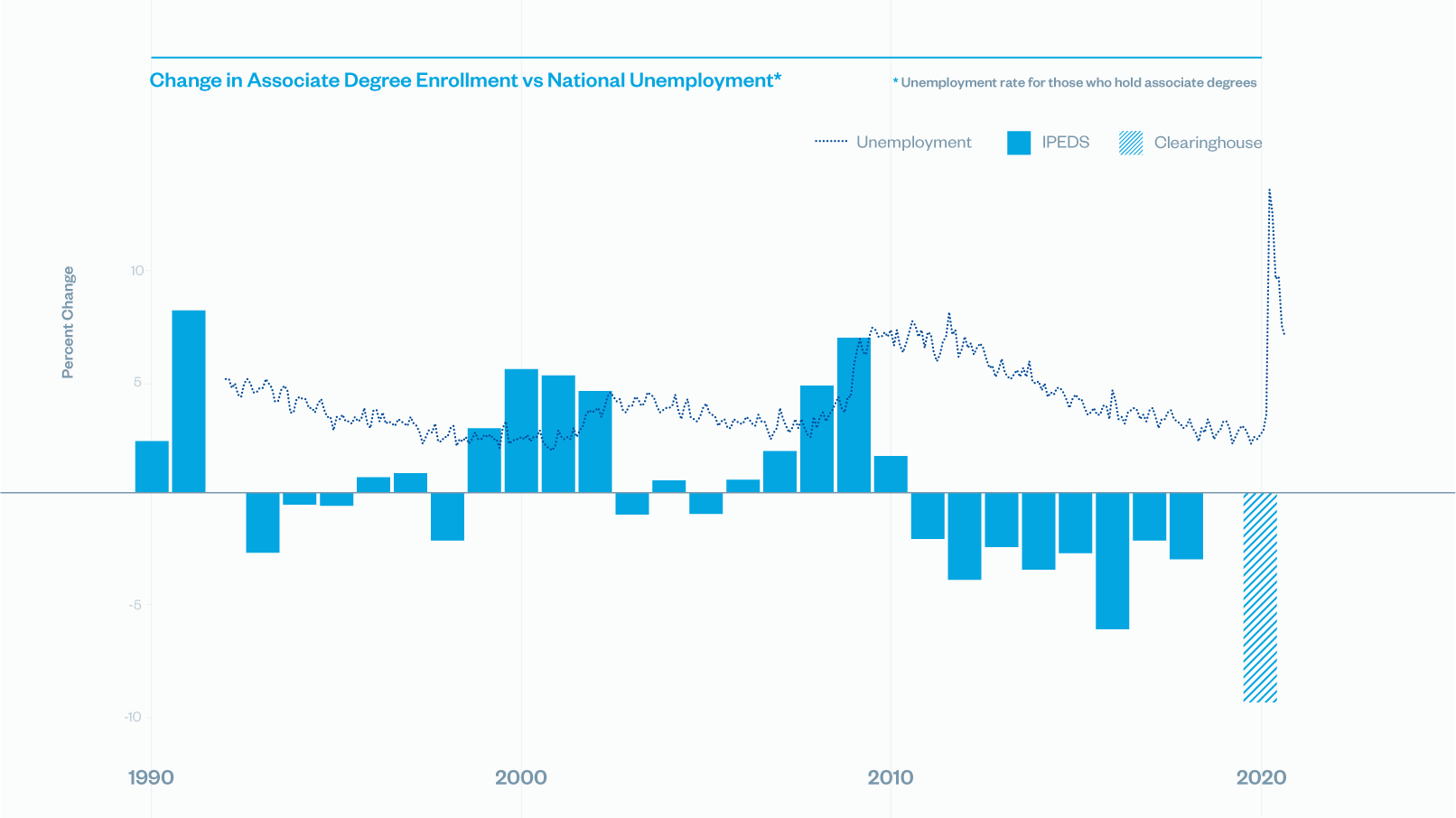Editor's Note: When the NSC released the first collection of data, we were concerned that the data was not representative enough of institutions across the country to draw meaningful conclusions. Only 20% of schools were self-reporting — which is an issue in and of itself as it is not a random sample, and several geographic regions were either underrepresented or not at all represented. Due to the nature of COVID 19 and how it has affected geographic regions across the US differently, this was problematic.
With NSC's latest data release, more than 50% of schools are now reporting and all geographic regions are represented. While this is still not a random sampling, some of our concerns have been mitigated, and we're now comfortable drawing some high-level conclusions. However, we must caution that these findings may demonstrate bias and may change as more data is released.
Enrollment Impact on Public & Private Four-Year Institutions
.png?width=1611&name=clearinghouse__big-data%20(1).png)
Historically, enrollment at 4-year institutions increases during times of economic uncertainty. However, given how quickly COVID-19 spread in the US during those first few weeks of March, many colleges and universities were forced to close their campus just as they sent out their acceptance letters and financial aid packages for the fall. In the face of uncertainty, the data indicate many first-time students elected to defer enrollment.
While overall enrollment dropped by just 1.4% for public 4-year institutions, and by 2% for their private nonprofit counterparts, the New York Times reported a 16% drop in freshmen enrollment. This precipitous drop constitutes a large portion of the total enrollment declines. 4-year institutions had already seen several years of diminishing enrollment growth, meaning that the shock of COVID-19 related enrollment declines will likely overwhelm some institutions already facing strained balance sheets.
During the summer, one of the prevailing questions was what effect reopening plans would have on enrollment. Though it's still too early to tell definitively, it does not appear that reopening plans significantly impacted enrollment one way or another. Private institutions were nearly twice as likely to be in person, yet they still experienced a slightly larger enrollment decline (0.4%) than public institutions. Though there are confounding factors here, and this question will need to be revisited, it appears that with the data we have now, there was not a significant difference in enrollment between institutions that were hybrid, online, or in person. As more disaggregated data is released, we'll monitor if this trend continues.

Enrollment Impact on Two-Year Public Institutions
Community colleges are known to offer a wide range of flexible and affordable education options that cater to a diverse array of students. Yet, 2-year public institutions have seen dwindling enrollment for the past several years. In a 2018 article from Inside Higher Ed, they outline several long-term threats to community college enrollment. Community colleges also struggle with retention. Enrollment Advisory Firm, EAB, found that out of 100 students who apply to a two-year college, 56 are lost during onboarding, another 23 drop out, and just five are still enrolled after six years. Only 9 of the initial 100 complete an associate degree.
For many students, enrollment in community college doesn't come with the same emotional gravity as that of 4-year institutions, given the efficiency of the community college admissions process. This means that the admissions process is far less cyclical and more sensitive to short-term disruption.
Historically, community colleges have been amongst the most responsive of any institution type to economic fluctuation. Given the tremendous economic volatility, we would expect to see a surge in enrollment. Instead, we see the opposite: Public 2-year institutions are reporting an extraordinary 22.7% drop in first-time beginning student enrollment. Whether this trend is a short-term setback or indicative of a long-term change will be crucial to monitor as this crisis matures.
We don't have disaggregated data yet, but it appears the flexible application model that many of these schools employ may have been hit extra hard by the uncertainty of COVID-19. These institutions already struggle with losing students during matriculation, and the continued uncertainty with the pandemic almost certainly exacerbated that trend.
In recent years, an area of growth for community colleges has been dual enrollment. In Texas, nearly 25% of students enrolled in community college were dual-enrolled high school students. More and more, community colleges are primarily enrolling traditional-age students, which puts them in direct competition with 4-year institutions. With many high schools struggling with their COVID-19 response, it's had an adverse effect on those dual enrollment programs.
Moreover, COVID-19 has been shown to disproportionately effect Latinx communities across the country. Latinx students have also reported that their higher education plans have been more impacted by COVID-19 than their peers and are more worried about returning to campus than their peers. Given that Latinx students account for 25% of all community college enrollment, at least part of the decline in 2-year public institutions can be attributed to the adverse experiences of these students and their families. The uncertainty among this subset of students contributes to the overall declines we see with these schools.
Chart: Change in 2-year public enrollment depicted against national unemployment.
Questions for consideration:
- How quickly will the Latinx community recover from COVID-19?
- How quickly will those that held off on pursuing their education due to the pandemic return to the classroom? Or will they return at all?
- What does that mean for the future of representation of the Latinx community in the workforce? If Latinx students delay continuing their education or don't return at all, will we lose a generation of Latinx teachers, nurses, and other leaders? How will that impact the younger generation as their role models become harder to see?
Enrollment Impact on Graduate Degree Programs
To this point, graduate degree enrollment has proven to be resilient in this crisis, though the graduate enrollment process is slower than many other program types analyzed here. In fact, many elite business schools are reporting double-digit increases in applications for their programs beginning in 2021, with several reporting all-time enrollment records. If this trend continues across the sector, graduate programs may be one of the best spots for schools to make up for revenue shortfalls due to fallen undergraduate enrollment and significant auxiliary revenue declines.
It's premature to attribute the current enrollment growth solely to the economic impacts of COVID-19, but we do hypothesize that this will be the case in the future. Given anecdotal evidence of the increase in graduate program interest and the already significant increase in enrollment amid the pandemic, we expect a surge in graduate enrollment over the next year.

Chart: Change in graduate program enrollment depicted against national unemployment.
Questions for consideration:
- While graduate programs typically account for only a small portion of an institution's total enrollment, they tend to be a significant revenue source. What stress will be placed on these programs in the coming years as institutions try to make up for lost revenue?
- How will colleges and universities position themselves for a potential influx of interest in graduate programs?
- Will schools prepare for larger graduate populations or use the influx of interest to create greater selectivity in their admissions?
- Should institutions restructure resources to support a larger graduate population to offset some of the losses at the undergraduate enrollment level?
Enrollment Impact on Online Degree Programs
The data clearly indicate a true market demand for this kind of program — online enrollment is one of the few bright spots we see in all of higher ed enrollment. As the return to a traditional on-campus student experience remains uncertain, effective online learning will continue to be an important differentiator. While it's impossible to predict what will happen with online enrollment in the future, it's reasonable to assume that the influx of online programs may become a viable alternative to students who otherwise wouldn't have previously considered it, especially as the average age of the college student continues to rise.

Is Higher Ed Still Recession Proof?
That's why it's imperative for the industry to collectively articulate why higher education is still a source of hope, stability, and opportunity for our country. Schools need to double-down on their brand's promise, now more than ever. We need to pivot to the opportunities this unprecedented time has created while ensuring that the most vulnerable students are supported.
Alex Ahlstrom is a SimpsonScarborough Data Analyst and took on the lion's share of analysis work for this piece. A graduate of American University with a B.S. in Economics, he was shaped by living in Madagascar for two years which established his passion for development and behavioral economics. Meredith Simpson, AVP of Research, and Malachi Koop, Director of Marketing, also contributed to this article. Read more about the rest of the SimpsonScarborough team here.












